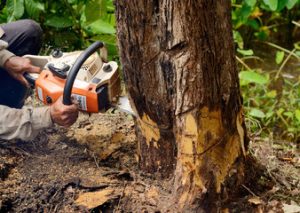Trees are an important part of the landscape but sometimes they can become undesirable due to thorniness, brittleness, or heavy fruiting. In these cases, tree removal may be necessary.

This is a delicate job that requires expertise. It involves precision notch cuts and escape routes to ensure safety for the workers. Contact Tree Removal for professional help.
Some trees need to be removed to protect buildings or people. They may also need to be removed in order to make way for major improvements, such as road widenings. Tree removal is always thoughtfully evaluated and only done if it’s necessary. Trees are valuable assets that contribute to the beauty and health of our community. Whenever possible, the City seeks ways to preserve existing trees while making safety improvements.
The assessment process includes inspecting the site and identifying the condition of each individual tree, as well as determining the overall risk to the area. The tree’s overall appearance, strength of limbs and trunk, growth habits, soil conditions and other factors can influence its condition. An inspection can reveal problems such as rot, fungal growth, insect infestation, and structural deficiencies. These can all be a safety risk and must be corrected.
If a problem is identified, the city’s arborist will recommend corrective measures. If corrective measures are not feasible, the tree will be removed. This decision is made based on several criteria including the potential impact of the tree on the surrounding landscape, structure and environment, as well as the cost and complexity of the correction.
In the event of a catastrophic storm, communities begin the recovery process by understanding where debris exists and estimating its volume. Debris assessment is a vital component of this process, as it helps determine whether or not a disaster declaration will be needed to access federal funds and resources.
To perform a debris assessment, open the ArcGIS app on your mobile device and sign in to your organization. Tap Map to view assessments captured near your location. To edit an assessment, tap it and then select Edit. Change the Status from Assessed to Removed and tap Send now.
When a tree is removed from the public right of way, the property owner must submit a Native Plant Mitigation Plan to offset the loss. The plan must include the species, variety and size of the replacement tree. It must also include the approximate planting cost of the new tree and the location within the right-of-way. This process can take up to two weeks to complete.
Safety First
Tree removal is a significant task that requires proper techniques and safety precautions. Injuries and property damage can occur if the process is performed incorrectly or without proper safety measures. Whether you’re removing a damaged, diseased, or dead tree, or simply want to clear space for a construction project, understanding the essential steps of the process will help ensure its success. In this comprehensive guide, you’ll learn the steps, techniques, and safety measures to remove trees effectively and safely.
Performing tree removal involves a variety of equipment and safety measures to prevent injuries and accidents during the process. This includes chainsaws with the appropriate power and length for the job, climbing gear and ladders, rigging equipment to control the direction of the tree fall and lower sections, and protective safety equipment like helmets and harnesses. Professionals also use advanced tools like specialized climbing equipment and cranes to work on taller, more difficult to reach trees.
In addition to ensuring the safety of those performing the work, tree removal professionals take care to protect surrounding property and structures. This can include establishing a secure work zone that’s marked with warning tape or cones to keep people and pets away from dangerous areas. It’s also important to check the condition of nearby buildings, power lines, and other structures, and to avoid working during inclement weather to minimize the risk of damage.
A variety of circumstances may call for the removal of a tree. Some of the most common include:
Proximity to Structures: When a tree is in close proximity to a house, it poses a potential risk to the structure and should be removed promptly. This is particularly true if the tree is dead or dying or showing signs of instability.
Overcrowding and Growth Issues: Trees that overtake other vegetation can become unsightly and obstruct views or impede traffic flow. They may also be a fire hazard or interfere with power lines.
In these situations, it’s important to consult with a professional and hire tree service experts. These specialists can assess the health and structural integrity of the trees on your property and provide expert recommendations for their removal. They can also offer tree-planting services, ensuring that healthy trees are replaced in the landscape.
Equipment
There are a variety of tools and equipment needed for tree removal, from safety and protective gear to small hand tools and larger machinery. Hiring a professional service is strongly recommended to ensure the job is done properly and safely.
A chainsaw is a key piece of equipment for tree cutting. It can be used to cut the trunks of a tree and also remove the branches and limbs. A good tree cutter should know the best ways to use a chainsaw for safe and effective removal of a tree.
Another important piece of equipment is a stump grinder. This machine grinds a tree stump and roots into a wood chip that can then be hauled away with a dump truck. This will be especially useful in areas where there are many large stumps that need to be removed from a yard or construction site.
In addition to the major machines that are needed, there are a variety of smaller pieces of equipment such as hand tools and a grapple bucket. These tools will help in removing the more difficult branches and limbs from the tree. They can also be used for cleaning up the debris left behind by the tree after it is cut down.
A crane is also a very important piece of equipment for tree removal. This can be used to reach the upper parts of a tree that are not easily accessible by other means such as a ladder. It can also be used for larger trees that are located in tight spaces and need to be moved a short distance.
Lastly, a dump truck is also needed to transport the large logs that are removed from the tree. It is a good idea to have the logs placed close together so that they can be moved more quickly and easily.
If you are looking for a way to increase the efficiency of your tree removal work, a skid steer attachment can make all the difference. These versatile and powerful compact construction machines are a favorite of forestry professionals and land clearing contractors alike. By pairing your skid steer with the right tree removal and land prep attachments, days on the job will be much more productive and efficient.
Hiring Professionals
Trees are beautiful additions to any lawn, but they can also cause a lot of damage if not maintained properly. Unhealthy or dead trees can wreak havoc with houses and car foundations, and falling limbs can destroy roofs, windows, and power lines. Professionals know how to safely remove and maintain trees to avoid this type of damage. They also have the equipment to take down large or dangerous trees, and they can help you select the right type of tree for your yard.
Tree removal services can also save you time and money by reducing the amount of cleanup you need to do. They also follow strict safety protocols, minimizing the chance of an accident. By contrast, if you attempt to remove a tree yourself and something goes wrong, you could be held liable for any injuries or property damage that resulted. A reputable tree service company is backed by insurance that protects you against liability claims.
Another benefit of hiring a professional tree service is that they can help you comply with local laws and regulations regarding your property’s tree maintenance. This can be particularly important if you live in an area where there are restrictions on how tall or close to a home your trees can be. In addition, they are familiar with the different types of trees and can shape them to complement your landscaping. This creates a cohesive, attractive landscape that adds value to your home and is visually pleasing for anyone who visits.
Hiring professionals to perform a tree removal is an essential decision for homeowners. It’s often too risky for people without the proper equipment to try to do it themselves, and doing so can lead to serious injury or even death. Professionals have access to specialized equipment that can make this type of work much safer and easier than you could imagine, and they can take care of all the paperwork involved to prevent any legal complications. This leaves you free to spend your weekends enjoying your property instead of wrestling with heavy equipment and risking your life.

